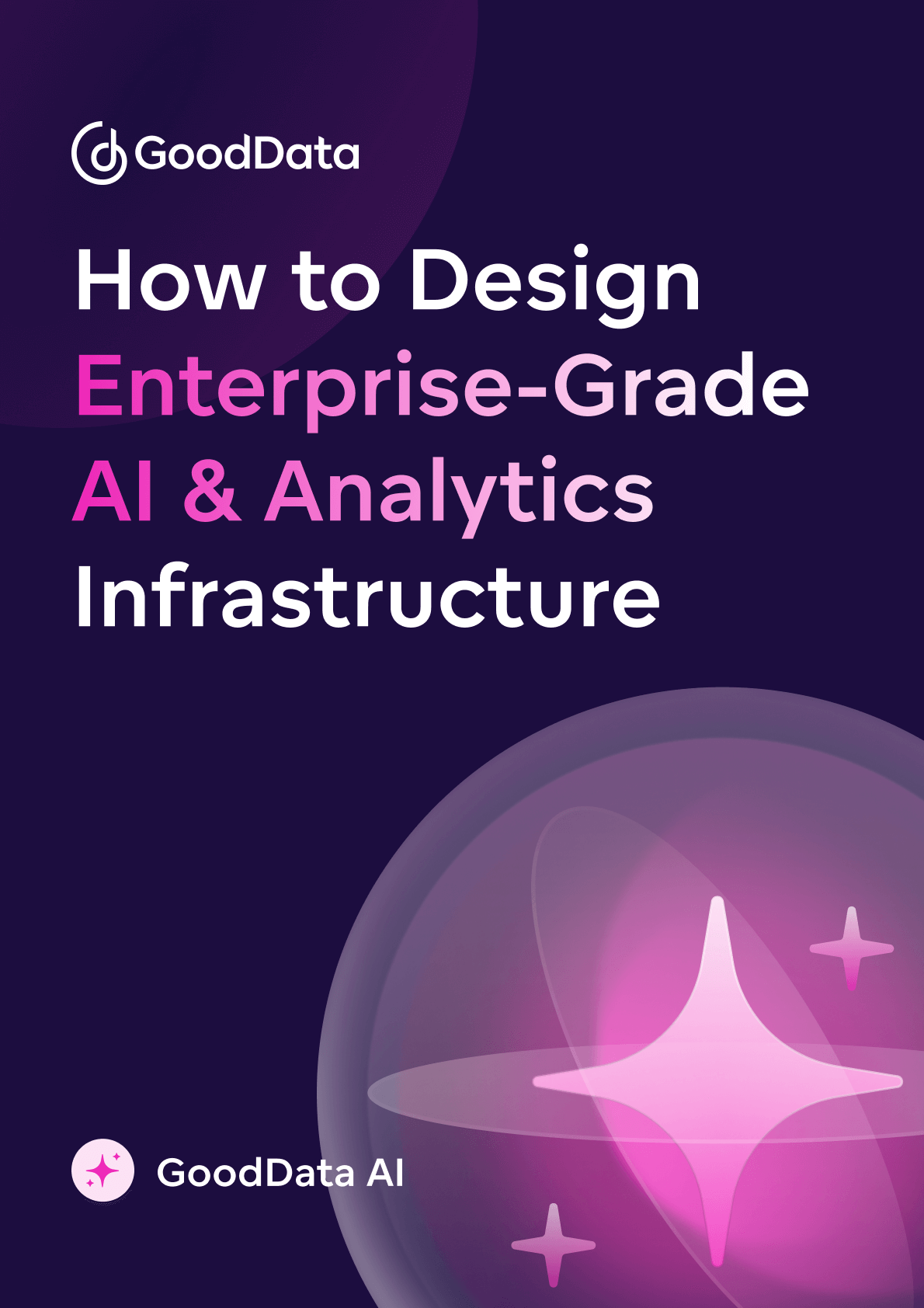
How to Design Enterprise-Grade AI & Analytics Infrastructure

Artificial intelligence is reshaping enterprise analytics. But beneath the hype, real adoption is struggling to scale beyond prototypes. What holds AI back isn’t raw capability, it’s architecture. Most systems are glued together with opaque models, brittle logic, and zero accountability.
Who Is This Whitepaper For?
This whitepaper is for analytics teams that want to apply AI in the most effective way. It lays out the core infrastructure, principles, and features required for a modern enterprise AI system that is explainable, governable, and future-proof. Our goal is to offer clarity: What does "enterprise-ready" actually mean in an AI world? And how can you get there?
What "Enterprise-Ready AI Infrastructure" Really Means
AI adoption at scale doesn’t just require powerful models, it also requires underlying systems designed for security, governance, and adaptability.
Modern enterprise AI must be:
- Composable: Built for plug-and-play across data systems, models, and interfaces.
- Governed: Enforced through policies, semantic modeling, and lineage-aware infrastructure.
- Business-Aligned: Trained and aligned to business terms and logic.
- Private-by-Design: Designed to function without raw data leaving trusted environments.
- Future-Oriented: Prepared for agentic automation, not only able to generate insights, and vendor-neutral.
The Modern AI Stack: 7 Core Layers
The following reference architecture synthesizes implementation patterns from enterprise-grade deployments. It aligns with Gartner’s guidance on composable analytics, AI governance (TRiSM), and enterprise AI maturity.
Each layer is essential to building AI systems that are secure, explainable, and production-ready.
1. Data Input & Preprocessing
Ingestion pipelines normalize data from warehouses, APIs, and transactional systems. Entity recognition, normalization, and metadata tagging are applied early.
Why it Matters: Without unified and trustworthy input data, downstream models will fail, regardless of their quality.
What to Look For:
- Support for diverse data sources (warehouse, SaaS, event streams)
- Metadata tagging and lineage capture on ingest
- Entity recognition and normalization at the edge
- Observability of ingestion flows (logs, retries, error reporting)
Technical Principles
- Streaming and batch ingestion separation
- Metadata capture via schema registry or sidecar
- Preprocessing hooks for NLP-aware tokenization
2. Semantic Layer & Ontology
Logical Data Models (LDMs) define business entities (e.g., Customer, Revenue). Ontologies enrich this with synonyms, units, and taxonomies, translating natural language into queryable context.
Why it Matters: AI needs structured understanding; this layer translates business concepts into machine-readable logic.
What to Look For:
- LDM support with reusable metrics and entities
- Ontology mapping to domain-specific terms
- Semantic constraints (units, types, ranges)
- Metadata tagging tied to access governance
Technical Principles
- Entity-relationship abstraction with inheritance
- Hierarchical term expansion and synonym resolution
- Versioned semantic models
3. Prompt Engineering Pipeline
Prompt templates are customized based on the task type and the target model. At this stage, business logic, filters, and access rules are injected directly into the prompt. The system also enforces token limits, escapes special characters, and validates the final prompt before sending it to the model.
Why it Matters: This layer ensures every AI request is grounded in context, access, and formatting, and routes it reliably to the right model.
What to Look For:
- Prompt templates by task type
- Metadata injection (filters, access, role)
- Error handling and fallback logic
- Multi-model prompt compatibility
Technical Principles
- Token budgeting strategies
- Prompt template versioning and testing
- Prompt-response fingerprinting (for caching, security)
4. Model Orchestration Layer
This layer routes prompts to the right model based on use case, latency, security, and cost. It supports LLMs (e.g., GPT-4o), SLMs (e.g., Claude Instant), and classic ML (e.g., XGBoost).
Why it Matters: You need the right model for the right job, as well as rules to switch between them safely.
What to Look For:
- Rule-based model routing
- Support for hybrid chains
- Model class fallback support (LLM → SLM → ML)
- Model performance observability
Technical Principles
- Model Abstraction Layer
- Routing Decision Graph
- Usage-based routing triggers
5. Execution & Interaction Layer
Handles UI and API-level interactions. Includes web chat, Slack, app widgets, and SDKs. Delivers answers, dashboards, and visualizations.
Why it Matters: This is where users experience AI (via UI, SDK, API, or chat) and where results must be fast, usable, and explainable.
What to Look For:
- NLQ interface support
- Headless SDK/API mode
- Embedded visual/chart generation
- User session tracking
Technical Principles
- Stateless vs session-based context handling
- UI-to-prompt mapping patterns
- UX latency budgeting (sub-second delivery)
6. Governance & Observability
Tracks, logs, and audits all prompt activity. Includes template versioning, session-level logging, and compliance traceability.
Why it Matters: Trust and scale require transparency. Without governance, AI outputs can’t be validated or trusted.
What to Look For:
- Full prompt + response logging
- Audit trails and revision history
- Governance dashboards
- Versioning for models, prompts, configs
Technical Principles
- GitOps-based governance flows
- Metadata logging schema (user, prompt, model, output)
- Drift and anomaly detection in model outputs
7. Deployment Infrastructure
Containerized for flexible scale (e.g., Kubernetes), supports BYOM (bring your own model), and enforces tenant isolation for multi-user environments.
Why it Matters: Flexibility, isolation, and performance all hinge on modern infrastructure that’s cloud-ready and secure by default.
What to Look For:
- Workspace-level isolation
- BYOM with API override
- K8s-compatible container design
- Deployment observability
Technical Principles
- Ephemeral runtime contexts per workspace
- Agent sandboxing and audit fencing
- Configurable tenant-specific routes
Building Trust at Scale: The Governance Checklist
We have already covered governance as a technical layer, including logging, versioning, and auditability. But building trust in AI systems doesn’t stop with infrastructure. Enterprise-ready AI must operationalize governance across roles, risk, and real-world use.
This section outlines what that looks like in practice and why it’s essential.
1. Align Governance to the Full Lifecycle
Governance doesn’t have a quick fix. It’s a framework that spans every phase of your AI stack:
- People and roles — Who owns prompt design, model validation, and access control?
- Policies and workflows — Are prompts and models audited, approved, and version-controlled?
- Release readiness — Are there promotion gates for prompts, templates, and model updates?
This mirrors Gartner’s guidance on TRiSM (Trust, Risk, and Security Management), emphasizing governance as a continuous discipline rather than just checking a compliance box.
2. Make Every Step Explainable
Trust starts with transparency. From question to output, every decision in the pipeline should be inspectable.
For example, a well-instrumented system might log the following metadata:
{
"user_input": "Why did Q1 revenue drop in APAC?",
"applied_prompt_template": "{metric} breakdown by {region} and {quarter}",
"selected_model": "gpt-4o",
"data_source": "Revenue_KPI_Definition_v2.json",
"generated_output": "Q1 revenue in APAC fell 17% due to underperformance in Japan and Australia."
}
This tracking enables debugging, downstream auditing, quality assurance, and explainability for end users or compliance teams.
3. Monitor in Real-Time
It’s not enough to log history. You need visibility as the system runs. This includes:
- Unique trace IDs across multi-step prompts
- Session-level metadata (user, intent, model, context)
- Drift and anomaly detection for hallucinations or unexpected outputs
Compliance dashboards for retry rates, model fallbacks, and redactions
4. Calibrate Risk to the Use Case
Not every insight needs the same level of oversight. Controls should be aligned with context:
Low
Use Case
Ad hoc search
Governance Requirement
Logging only
Medium
Use Case
Business summaries
Governance Requirement
Human review, template approval
High
Use Case
Regulatory/predictive outputs
Governance Requirement
Full audit trail, approval flow
This helps scale governance without blocking innovation.
5. Plan for Ethical Risk and Bias
Unbiased data ≠ unbiased AI. Your governance stack should help flag and address ethical risks:
- Prompt traceability for identifying model bias
- Model performance monitoring across user cohorts
- Human-in-the-loop for sensitive decisions
- Transparency into model selection logic (e.g., why GPT-4o vs Claude)
The Bottom Line
Governance is not a barrier, it’s what makes AI safe to scale.
When done right:
- Prompt review improves quality
- Logs enable retraining and iteration
- Audit trails unlock AI in regulated environments
- Ethical controls protect teams and end users
If your AI system can’t explain how it arrived at a result, it can’t be trusted. And if it can’t be trusted, it can’t scale, no matter how powerful the model.
From Assistants to Agents: Architecting for Evolution
Today, most enterprise AI begins with assistants: reactive tools that answer questions in natural language. But tomorrow’s systems will be agents: proactive collaborators that reason, plan, and act on behalf of users.
This transition doesn’t require starting over. It requires infrastructure that’s modular, governed, and context-aware, so assistants can evolve into agents over time, without breaking trust or safety.
Why does this matter?
Agentic systems mark the shift from response to reasoning and from generating answers to pursuing goals. That shift relies on infrastructure, not just model size.
If your system can understand intent, maintain context, orchestrate actions, and measure outcomes, you’re already halfway there.
What Agentic AI Needs
To operate as agents, AI systems require a modular architecture of key components:
- Perception — Ingest signals, queries, and events
- Planner — Break down goals into task sequences
- Executor — Trigger workflows, prompts, or APIs
- Memory — Store interaction history and results
- Evaluator — Score outputs based on utility, quality, or cost
These functions enable multi-step reasoning, long-term goals, and human-like adaptation.
Degrees of Autonomy
Like humans, agents grow into responsibility:
- Level: Guided chart generation
- Level: Anomaly detection
- Level: Explanation and pattern recognition
- Level: Strategic simulation
- Level: Autonomous action and remediation
This mirrors Gartner’s agency maturity model and helps businesses pace their own readiness.
Design Considerations
Before deploying agentic AI, teams must design for:
- Clear goal boundaries and escalation paths
- Human-in-the-loop failover points
- Observability across planning, memory, and action
- Sandboxed execution environments for testing safely
You may not deploy a full agent today, but your architecture should make that future possible.
How You Can Implement These Architectural Pillars Today
Consider this whitepaper as your technical guide. The principles outlined above offer a clear framework for evaluating AI platforms or designing your own.
Remember, enterprise-grade AI must be able to explain its reasoning, seamlessly integrate into your existing systems, and rigorously protect your valuable data.
Real platforms, like GoodData AI, already demonstrate this architecture with ontology-driven prompting, metadata-only LLM interaction, a composable API-first stack, governance integration, and deployment flexibility.
Continue Reading This Article
Enjoy this article as well as all of our content.
Does GoodData look like the better fit?
Get a demo now and see for yourself. It’s commitment-free.










